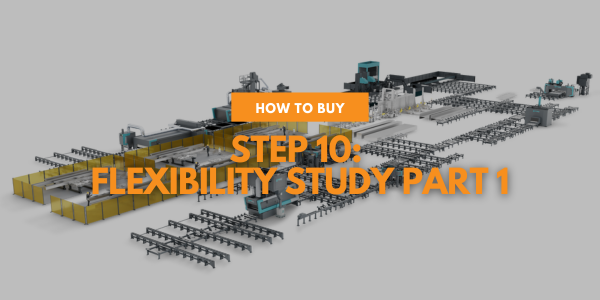How to buy - Step 10) Flexibility Study Part 1

FLEXIBILITY STUDY PART 1 – MANUFACTURING FLEXIBILITY & THE ECONOMIC BENEFITS
The purpose of this flexibility study is to understand what has changed in your business and your markets during the previous 3 years. Also, what changes are necessary to continue to be competitive over the short & medium term. The purpose of this flexibility study is to carry out an assessment of the need for, and relevance of flexibility in your company’s manufacturing operations. This flexibility study is entirely about information that already exists in your business as well as external market changes.
FLEXIBILITY STUDY OBJECTIVES
The “Flexibility Solution Design Process” as a whole requires complex calculations, such as the actual and needed flexibility, cost justification, ROI issues etc. All available flexibility solutions and gathered data must be correlated. The purpose of this study is to assess the need for flexibility in a manufacturing facility. Specifically, models to quantify the internal and external changes experienced, evaluate the needed flexibility and suggest the value loaded flexible solution to address these changes are developed. Flexible systems are known to enable organisations to take advantage of diversified products, low volume production items with short life cycles. They also improve the ability to respond to market changes. Flexibility is a strategic manufacturing imperative.
PROCESS FLEXIBILITY
Process flexibility of a manufacturing system refers to the set of product types that the system can produce without major setups. Thus, a needed measure of process flexibility would be the set of product types a system needs to produce, without major setups to address the market demand. The main purpose of process flexibility is to reduce batch sizes and reduce inventory costs. Process flexibility satisfies the strategic need of being simultaneously capable and available. Because of the high initial capital outlay involved, the selection of the appropriate flexible solution is a critical issue. This methodology will determine the value loaded and feasible flexibility strategy.
BACKGROUND INFORMATION
Various industries have begun to implement the philosophies of flexible manufacturing due to competition, short life cycles and cost implications. Facilities are realising that flexibility is a necessity for their future survival. While considering automation, it is critical that each solution be tailored specifically to address the facility in consideration to ensure that corrective actions are taken to address the facility needs. Laying new technology on top of old processes has shown to be a significant waste of time and money. Technology must be used to innovate processes, not automate bottlenecks. Any technology applied without a strategic plan will not work.
FLEXIBILITY MEASUREMENT
Flexibility is defined as the ability of a system to adjust to the changes in its internal or external environment. Thus it is important to understand that there is no flexibility without a change. In adapting to these changes a conventional facility will experience a performance loss. The goal of flexible manufacturing, therefore, is to change or react with little penalty in time, effort, or performance so that zero or minimum loss is experienced.
PROCESS FLOW
The various modules involved in the process of developing this tool were:
- Flexibility Survey
- Flexibility Study
- Preliminary Strategy Identification
- Strategy Implementation Feasibility
- Value Loaded Strategy Selection
FLEXIBILITY SURVEY
A comprehensive flexibility questionnaire was sent to different companies around the world to investigate flexibility awareness in the industry, and to identify the most important types of flexibilities. A flexibility study is developed to analyse and evaluate the changes taking place in a facility’s environment. These changes and a measurement scheme are then used to calculate the needed measure of five types of flexibilities. The flexibility study provides the percentage gap between the actual and needed measures that are used to select the appropriate strategy. Finally, factors like ROI; opportunity cost, organisational readiness and top management support are considered to determine the value loaded strategy. This flexibility study develops the needed measures for five types of flexibilities:
- Machine Flexibility
- Scheduling Flexibility
- Process Flexibility
- Product Flexibility
- Volume Flexibility
- You will gain enormous value you will gain from having a validated data set, that can be peer-reviewed, to justify and evidence your selection. This will process questions and answers that you may not have considered before and also give you the road map to plot your ROI.
- Capital purchasing is a fundamental part of how your business grows. I have a duty of care to all of my clients, manufacturers and to myself to maximise utilisation and ROI.
Learn More
Contact Specialist Machinery Sales today to discuss a superior machinery strategy for your business.
